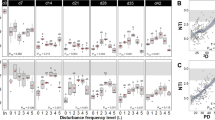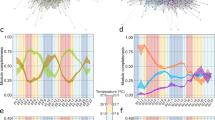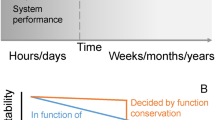Abstract
A replicate long-term experiment was conducted using anaerobic digestion (AD) as a model process to determine the relative role of niche and neutral theory on microbial community assembly, and to link community dynamics to system performance. AD is performed by a complex network of microorganisms and process stability relies entirely on the synergistic interactions between populations belonging to different functional guilds. In this study, three independent replicate anaerobic digesters were seeded with the same diverse inoculum, supplied with a model substrate, α-cellulose, and operated for 362 days at a 10-day hydraulic residence time under mesophilic conditions. Selective pressure imposed by the operational conditions and model substrate caused large reproducible changes in community composition including an overall decrease in richness in the first month of operation, followed by synchronised population dynamics that correlated with changes in reactor performance. This included the synchronised emergence and decline of distinct Ruminococcus phylotypes at day 148, and emergence of a Clostridium and Methanosaeta phylotype at day 178, when performance became stable in all reactors. These data suggest that many dynamic functional niches are predictably filled by phylogenetically coherent populations over long time scales. Neutral theory would predict that a complex community with a high degree of recognised functional redundancy would lead to stochastic changes in populations and community divergence over time. We conclude that deterministic processes may play a larger role in microbial community dynamics than currently appreciated, and under controlled conditions it may be possible to reliably predict community structural and functional changes over time.
Similar content being viewed by others
Log in or create a free account to read this content
Gain free access to this article, as well as selected content from this journal and more on nature.com
or
Accession codes
References
Albertsen M, Hugenholtz P, Skarshewski A, Nielsen KA, Tyson GW, Nielsen PH . (2013). Genome sequences of rare, uncultured bacteria obtained by differential coverage binning of multiple metagenomes. Nat Biotechnol 31: 533–538.
Allison SD, Martiny JBH . (2008). Resistance, resilience, and redundancy in microbial communities. Proc Natl Acad Sci USA 105: 11512–11519.
Altschul SF, Gish W, Miller W, Myers EW, Lipma DJ . (1990). Basic local alignment search tool. J Mol Biol 215: 403–410.
Amani T, Nosrati M, Sreekrishnan TR . (2010). Anaerobic digestion from the viewpoint of microbiological, chemical and operational aspects - a review. Environ Rev 18: 255–278.
Amann RI, Ludwig W, Schleifer KH . (1995). Phylogenetic identification and in situ detection of individual microbial cells without cultivation. Microbiol Rev 59: 143–169.
APHA (2005) Standard Methods for the Examination of Water and Wastewater 21st edn. American Public Health Association: Washington DC.
Ariesyada HD, Ito T, Okabe S . (2007). Functional bacterial and archaeal community structures of major trophic groups in a full-scale anaerobic sludge digester. Water Res 41: 1554–1568S.
Bayer EA, Belaich J-P, Shoham Y, Lamed R . (2004). The cellulosome: multienzyme machines for degradation of plant cell wall polysaccharides. Annu Rev Microbiol 58: 521–554.
Bragg L, Stone G, Imelfort M, Hugenholtz P, Tyson G . (2012). Fast, accurate error-correction of amplicon pyrosequences using Acacia. Nat Methods 9: 425–426.
Briones A, Raskin L . (2003). Diversity and dynamics of microbial communities in engineered environments and their implications for process stability. Curr Opin Biotechnol 14: 270–276.
Caporaso JG, Kuczynski J, Stombaugh J, Bittinger K, Bushman FD, Costello EK et al. (2010). QIIME allows analysis of high-throughput community sequencing data. Nat Methods 7: 335–336.
Caruso T, Chan Y, Lacap DC, Lau MCY, McKay CP, Pointing SB . (2011). Stochastic and deterministic processes interact in the assembly of desert microbial communities on a global scale. ISME J 5: 1406–1413.
Cayford BI, Dennis PG, Keller J, Tyson GW, Bond PL . (2012). High-throughput amplicon sequencing reveals distinct communities within a corroding concrete sewer system. Appl Environ Microbiol 78: 7160–7162.
Daims H, Bruhl A, Amann R, Schleifer KH, Wagner M . (1999). The domain-specific probe EUB338 is insufficient for the detection of all bacteria: development and evaluation of a more comprehensive probe set. Syst Appl Microbiol 22: 434–444.
Dar SA, Kleerebezem R, Stams AJM, Kuenen JG, Muyzer G . (2008). Competition and coexistence of sulfate-reducing bacteria, acetogens and methanogens in a lab-scale anaerobic bioreactor as affected by changing substrate to sulfate ratio. Appl Microb Biotechnol 78: 1045–1055.
Dennis PD, Guo K, Imelfort M, Jensen PD, Tyson GW, Rabaey K . (2013). Spatial uniformity of microbial diversity in a continuous bioelectrochemical system. Bioresour Technol 129: 599–605.
DeSantis TZ, Hugenholtz P, Larsen N, Rojas M, Brodie EL, Keller K et al. (2006). Greengenes, a chimera-checked 16S rRNA gene database and workbench compatible with ARB. Appl Environ Microbiol 72: 5069–5072.
Dryden IL . (2013). Shapes: Statistical Shape Analysis. R package version 1.1-9 http://CRAN.R-project.org/package=shapes.
Edgar RC . (2010). Search and clustering orders of magnitude faster than BLAST. Bioinformatics 26: 2460–2461.
Edgar RC, Haas BJ, Clemente JC, Quince C, Knight R . (2011). UCHIME improves sensitivity and speed of chimera detection. Bioinformatics 27: 2194–2200.
Engelbrektson A, Kunin V, Wrighton KC, Zvenigorodsky N, Chen F, Ochman H et al. (2010). Experimental factors affecting PCR-based estimates of microbial species richness and evenness. ISME J 4: 642–647.
Falk MW, Song K-G, NMatiasek MG, Wuertz S . (2009). Microbial community dynamics in replicate membrane bioreactors - natural reproducible fluctuations. Water Res 43: 842–852.
Fernandez A, Huang S, Xing J, Hickey R, Criddle C, Tiedje J . (1999). How stable is stable? Function versus community composition. Appl Environ Microbiol 65: 3697–3704.
Ge H, Jensen PD, Batstone DJ . (2011). Temperature phased anaerobic digestion increases apparent hydrolysis rate for waste activated sludge. Water Res 45: 1597–1606.
Gentile ME, Nyman JL, Criddle CS . (2007). Correlation of patterns of denitrification instability in replicated bioreactor communities with shifts in the relative abundance and denitrification patterns of specific populations. ISME J 1: 714–728.
Gopalan P, Jensen PD, Batstone DJ . (2013). Anaerobic digestion of swine effluent: impact of production stages. Biomass Bioenergy 48: 121–129.
Griffin ME, McMahon KD, Mackie RI, Raskin L . (1997). Methanogenic population dynamics during start-up of anaerobic digesters treating municipal solid waste and biosolids. Biotechnol Bioeng 57: 342–355.
Harpole WS . (2012). Neutral theory of species diversity. Nat Educ Knowledge 3: 60.
Jacob-Lopes E, Scoparo CHG, Lacerda L, Franco TT . (2009). Effect of light cycles (night/day) on CO2 fixation and biomass production by microalgae in photobioreactors. Chem Eng Proc 48: 306–310.
Jaenicke S, Ander C, Bekel T, Bisdorf R, Dröge M, Gartemann K-H et al. (2010). Comparative and joint analysis of two metagenomic datasets from a biogs fermenter obtained by 454-pyrosequencing. PLoS One 6: 1–15.
Jensen PD, Hardin MT, Clarke WP . (2009). Effect of biomass concentration and inoculum source in the rate of anaerobic cellulose solubilization. Biores Technol 2009: 5219–5225.
Jensen PD, Ge H, Batstone DJ . (2011). Assessing the role of biochemical methane potential tests in determining anaerobic degradability rate and extent. Water Sci Technol 64: 880–886.
Kamagata Y, Mikami E . (1991). Isolation and characterization of a novel thermophilic Methanosaeta strain. Int J Syst Bacteriol 41: 191–196.
Kong Y, Xia Y, Seviour R, He M, McAllister T, Forster R . (2012). In situ identification of carboxymethyl cellulose–digesting bacteria in the rumen of cattle fed alfalfa or triticale. FEMS Microbiol Ecol 80: 159–167.
LaPara TM, Nakatsu CH, Pantea LM, Alleman JE . (2001). Stability of the bacterial communities supported by a seven-stage biological process treating pharmaceutical wastewater as revealed by PCR-DGGE. Water Res 36: 638–646S.
Lee C, Kim J, Shin SG, Hwang S . (2008a). Monitoring bacterial and archaeal community shifts in a mesophilic anaerobic batch reactor treating a high-strength organic wastewater. FEMS Microbiol Ecol 65: 544–554.
Lee C, Kim JY, Hwang K, O'Flaherty V, Hwang S . (2008b). Quantitative analysis of methanogenic community dynamics in three anaerobic batch digesters treating different wastewaters. Water Res 43: 157–165.
Legendre P, Gallagher ED . (2001). Ecologically meaningful transformations for ordination of species data. Oecologia 129: 271–280.
Liu Y, Whitman WB . (2008). Metabolic, phylogenetic, and ecological diversity of the methanogenic archaea. Ann NY Acad Sci 1125: 171–189.
Ma K, Liu X, Dong X . (2006). Methanosaeta harundinacea sp. nov., a novel acetate-scavenging methanogen isolated from a UASB reactor. Int J Syst Evol Microbiol 56: 127–131.
Magnuson A, Anderlund M, Johansson O, Lindblad P, Lomoth R, Polivka T et al. (2009). Biomimetic and microbial approaches to solar fuel generation. Acc Chem Res 42: 1899–1909.
Matano Y, Park JS, Goldstein MA, Hoi RH . (1994). Cellulose promotes extracellular assembly of Clostridium cellulovorans cellulosomes. J Bacteriol 176: 6952–6956.
McDonald IR, Bodrossy L, Chen Y, Murrell JC . (2008). Molecular ecology techniques for the study of aerobic methanotrophs. Appl Environ Microbiol 74: 1305–1315.
McGuinness LM, Salganik M, Vega L, Pickering KD, Kerkhof LJ . (2006). Replicability of bacterial communities in denitrifying bioreactors as measured by PCR/T-RFLP analysis. Environ Sci Technol 40: 509–515.
Merlino G, Rizzi A, Villa F, Sorlini C, Brambilla M, Navarotto P et al. (2012). Shifts of microbial community structure during anaerobic digestion of agro-industrial energy crops and food industry byproducts. J Chem Technol Biotechnol 87: 1302–1311.
Muller B, Sun L, Schnurer A . (2013). First insight into the syntrophic acetate-oxidizing bacteria - a genetic study. Microbiologyopen 2: 35–53.
Muller N, Worm P, Schink B, Stams AJM, Plugge CM . (2010). Syntrophic butyrate and propionate oxidation processes: from genomes to reaction mechanisms. Environ Microbiol Rep 2: 489–499.
Nelson MC, Morrison M, Yu Z . (2011). A meta-analysis of the microbial diversity observed in anaerobic digesters. Bioresour Technol 102: 3730–3739.
Neuwirth E . (2011). RColorBrewer: ColorBrewer palettes. R package version 1.0-5 http://CRAN.R-project.org/package=RColorBrewer.
Ofiteru ID, Lunn M, Curtis TP, Wells GF, Criddle CS, Francis CA et al. (2010). Combined niche and neutral effects in a microbial wastewater treatment community. Proc Natl Acad Sci USA 107: 15345–15350.
Oksanen J, Blanchet G, Kindt R, Legendre P, Minchin PR, O'Hara RB et al. (2012). Vegan: Community ecology package. R package version 2.0-1. http://CRAN.R-project.org/package=vegan.
Pervin HM, GDennis PG, Lim HJ, Tyson GW, Batstone DJ, Bond PL . (2013). Drivers of microbial community composition in mesophilic and thermophilic temperature-phased anaerobic digestion pre-treatment reactors. Water Res 47: 7098–7108.
Pholchan MK, Baptista JC, Davenport RJ, Sloan WT, Curtis TP . (2013). Microbial community assembly, theory and rare functions. Front Microbiol 4: 1–9.
Rabaey K, Ossieur W, Verhaege M, Verstraete W . (2005). Continuous microbial fuel cells convert carbohydrates to electricity. Water Sci Technol 52: 515–523.
Regueiro L, Veiga P, Figueroa M, Alonso-Gutierrez J, Stams AJM, Lema JM et al. (2012). Relationship between microbial activity and microbial community structure in six full-scale anaerobic digesters. Microbiol Res 167: 581–589.
Rittmann BE, Hausner M, Loffler F, Love NG, Muyzer G, Okabe S et al. (2006). A vista for microbial ecology and environmental biotechnology. Environ Sci Technol 15: 1096–1103.
Schlüter A, Bekel T, Diaz NN, Dondrup M, Eichenlaub R, Gartemann K-H et al. (2008). The metagenome of a biogas-producing microbial community of a production-scale biogas plant fermenter analysed by the 454-pyrosequencing technology. J Biotechnol 136: 77–90.
Schnurer A, Schink B, Svensson BH . (1996). Clostridium ultunense sp. nov., a mesophilic bacterium oxidizing acetate in syntrophic association with a hydrogenotrophic methanogenic bacterium. Int J Syst Bacteriol 46: 1145–1152.
Sloan WT, Lunn M, Woodcock S, Head IM, Nee S, Curtis TP . (2006). Quantifying the roles of immigration and chance in shaping prokaryote community structure. Environ Microbiol 8: 732–740.
Stahl DA, Amann R . (1991). Development and application of nucleic acid probes. In: Stackebrandt E, Goodfellow M (eds) Nucleic Acid Techniques in Bacterial Systematics. John Wiley & Sons Ltd.: Chichester, England, pp 205–249.
Steinberg LM, Regan JM . (2011). Response of lab-scale methanogenic reactors inoculated from different sources to organic loading rate shocks. Bioresour Technol 102: 8790–8798.
Stieb M, Schink B . (1985). Anaerobic oxidation of fatty acids by Clostridium bryantii sp. nov., a sporeforming, obligately syntrophic bacterium. Arch Microbiol 140: 387–390.
Sundberg C, Al-Soud WA, Larsson M, Alm E, Yekta SS, Scvensson BH et al. (2013). 454 pyrosequencing analyses of bacterial and archaeal richness in 21 full-scale biogas digesters. FEMS Microbiol Ecol 85: 612–626.
Tyson GW, Chapman J, Hugenholtz P, Allen EE, Ram RJ, Richardson PM et al. (2004). Community structure and metabolism through reconstruction of microbial genomes from the environment. Nature 428: 37–43.
Valentin-Vargas A, Toro-Labrador G, Massol-Deya AA . (2012). Bacterial community dynamics in full-scale activated sludge bioreactors: Operation and ecological factors driving community assembly and performance. PLoS One 7: 1–12.
Wang J, Shen J, Wu Y, Chen T, Soininen J, Stegen JC et al. (2013). Phylogenetic beta diversity in bacterial assemblages across ecosystems: deterministic versus stochastic processes. ISME J 7: 1310–1321.
Weiland P . (2010). Biogas production: current state and perspectives. Appl Microbiol Biotechnol 85: 849–860.
Werner JJ, Knights D, Garcia ML, Scalfone NB, Smith S, Yarasheski K et al. (2010). Bacterial community structures are unique and resilient in full-scale bioenergy systems. Proc Natl Acad Sci USA 108: 4158–4163.
Wu S, Zhu Z, Fu L, Niu B, Li W . (2011). WebMGA: a customizable web server for fast metagenomic sequence analysis. BMC Genomics 12: 1–9.
Zhou J, Liu W, Deng Y, Jiang Y-H, ZXue K, He Z et al. (2013). Stochastic assembly leads to alternative communities with distinct functions in a bioreactor microbial community. mBio 4: 1–8.
Ziganshin AM, Liebetrau J, Proter J, Kleinsteuber S . (2013). Microbial community structure and dynamics during anaerobic digestion of various agricultural waste materials. Appl Microbiol Biotechnol 97: 5161–5174.
Acknowledgements
This study was supported by the Commonwealth Scientific & Industrial Research Organisation (CSIRO) Flagship Cluster ‘Biotechnological solutions to Australia’s transport, energy and greenhouse gas challenges’. IV acknowledges support by the University of Queensland International Scholarship, and GWT is supported by an ARC Queen Elizabeth II fellowship (DP1093175). KR acknowledges support by the European Research Council (Starter Grant Electrotalk). We thank Fiona May at the Australian Centre for Ecogenomics for the 16S rRNA gene amplicon pyrosequencing, Adam Skarshewski for his assistance with the pyrotag data analysis and Nancy Lachner and Serene Low for their help with the RT-PCR. Beatrice Keller and Nathan Clayton from the ASL analysis lab are acknowledged for the VFA analyses. We also acknowledge Dr Michael Imelfort for his contribution to the project.
Author information
Authors and Affiliations
Corresponding author
Ethics declarations
Competing interests
The authors declare no conflict of interest.
Additional information
Supplementary Information accompanies this paper on The ISME Journal website
Supplementary information
Rights and permissions
About this article
Cite this article
Vanwonterghem, I., Jensen, P., Dennis, P. et al. Deterministic processes guide long-term synchronised population dynamics in replicate anaerobic digesters. ISME J 8, 2015–2028 (2014). https://doi.org/10.1038/ismej.2014.50
Received:
Revised:
Accepted:
Published:
Issue date:
DOI: https://doi.org/10.1038/ismej.2014.50
Keywords
This article is cited by
-
Nitrogen deposition mediates more stochastic processes in structuring plant community than soil microbial community in the Eurasian steppe
Science China Life Sciences (2024)
-
MiDAS 5: Global diversity of bacteria and archaea in anaerobic digesters
Nature Communications (2024)
-
Functional and molecular approaches for studying and controlling microbial communities in anaerobic digestion of organic waste: a review
Reviews in Environmental Science and Bio/Technology (2023)
-
Stochastic processes dominate assembly of soil fungal community in grazing excluded grasslands in northwestern China
Journal of Soils and Sediments (2023)
-
Temporal Succession of Bacterial Community Structure, Co-occurrence Patterns, and Community Assembly Process in Epiphytic Biofilms of Submerged Plants in a Plateau Lake
Microbial Ecology (2023)



